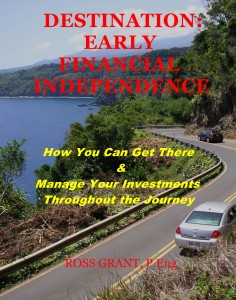
By Sandi Martin
Special to the Financial Independence Hub
In general, I don’t believe there’s ever much new under the investment sun; common-sense, low-cost, boringly well-diversified and regularly rebalanced portfolio management doesn’t sell newspapers, does it?
But the advent of online investment advice and management (robo-advisors, if you prefer) to the Canadian market is news, and — unlike much of what passes as financial “news” these days — it’s news that regular investors pursuing findependence should be paying attention to. For once, it’s an innovation whose promise to make common-sense investing cheaper and easier — and findependence closer — is believable.
I have only one caveat, and it’s for those of you close enough to findependence to start thinking about spending that money rather than saving it: the decumulation advice that these companies are offering now hasn’t had a chance to mature and develop as fully as it should.
It seems that the broad attitude is “yes, it’s important and we want to offer great withdrawal planning, but we’ll develop an advice framework and some good tools for that once we have more clients who are closer to needing it”.
How (and Why) to Choose between NestWealth, Wealth Simple, WealthBar, Shareowner and Steadyhand
The point of this post: Each online investment management company has a slightly different fee structure and value proposition. Calculating their relative cost for your circumstances will let you compare their relative value depending on the kind of service you want to pay for. (Includes a link to the Canadian Online Investment Advisor Fee Calculator.)
Canadian investors have traditionally had three choices for their savings:
- Open up a self-directed brokerage account and invest directly in stocks, bonds, ETFs or mutual funds.
- Go to the bank or invite that mutual fund/insurance salesperson you met while you were dropping your kids off at school over to your house, who will sell you mutual or segregated funds that cost in excess of 2% per year and pay her a commission based on the kind of funds they are and how expensive they are for you to own.
- Find a fee-only investment manager close enough to you to do business with, provided you have enough money (somewhere in the $500,000 to $1,000,000 range), and feel that paying 1-1.5% annually on that money is worth the management and financial planning advice you’ll get.
I unequivocally believe that — provided you have the relatively small amount of time necessary to set it up and maintain it and the relatively large amount of intestinal fortitude to stick with your plan no matter what the markets are doing — a self-directed, simple Couch Potato portfolio of low-cost, index ETFs is the best investment strategy for most Canadians.
A reasonably intelligent person should be able to follow an able guide like John Robertson’s soon-to-be-released The Value of Simple and do just fine, sometimes in combination with the service of an advice-only planner like me or most of the people on this list from MoneySense Magazine, or possibly by paying for the DIY Investor Service offered by PWL Capital to get set up.
But there are valid reasons to want someone else to manage your investments on an ongoing basis for you. Sound asset allocation, rebalancing across multiple accounts, and tax-efficiency can be worth paying for if you’re not going to be up to bothering with it yourself. And the value you get from having a calm sounding board when markets (or market noise) get crazy might actually be priceless if — like most of us — you’re tempted to get out of the market when you shouldn’t and question your plan just when you should be sticking to it dispassionately.
Really Important Sidebar
I want to be really, really clear about costs here: the lower you can get your annual investing costs, the better off you’ll be. This can’t be overstated. Seemingly small amounts add up over a lifetime of investing to very large amounts of your savings (see this post from Michael James on Money for a good set of charts). However, the question shouldn’t be “what’s the lowest cost?,” it should be “what’s the lowest cost that I will stick with?”
I also want to be clear that “investment management” and “financial planning” are not the same thing: financial planning is the context, the “what do I want my money to do for me,” and investment management is the tool, the “and this is how my money is going to do it.” It’s one of many tools, and (often) not the most important one. (End of Really Important Sidebar)
Online Investment Option Calculator
If you’re seriously looking at what the online advisors are offering (and you should be), I’d invite you to use the Canadian Online Investment Option Calculator** as a starting point to calculate the relative cost of each service. With that information, you can compare the different services based on where you fall on the “how much money do you have?” spectrum. That’s the objective part of the choice.
The subjective part of the choice (although each provider would probably argue it’s not subjective at all) is all the rest of the information you should spend some time gathering, preferably by calling each provider available in your province or territory, telling them where you fall on the “needs little advice” to “needs lots of advice” spectrum, and simply asking:
- how the portfolios are constructed
- how often they’re rebalanced
- what institution is the custodian for your money
- whether financial planning is included in the fee, if it’s purely investment management, or if all you’re paying for is access to the model portfolio with no other advice
- whether your money is managed across accounts as a single portfolio or whether each account is managed separately
- how simple it is to give them your money and get on with your life, and how simple and jargon-free the statements, online dashboard, and any ongoing communications are
- how often you’re able to talk to someone if you need to get persuaded off the ledge while the markets go crazy
- how well-developed their retirement income and decumulation strategies are
If you’re investing at the bank or with a salesperson that comes to your door, and have decided against investing on your own, write this down on a piece of paper right now:
“I will give myself until (date — no more than a month from now) to investigate the different online invesment options, and then I will decide on one and start the transfer process”
“I will give myself until (date – no more than a month from now) to investigate the different online investment options, compare the service they offer to the service I’m actually getting from my asset manager, and then I will decide whether to continue with my asset manager, negotiate a lower fee, or start the transfer process”
—
*Not to be confused with their build your own portfolio service, which – for the purposes of this comparison – isn’t a contender.
**I have to thank John Robertson, blogger behind holypotato.net and author of The Value of Simple for his invaluable assistance with the vagaries of conditional formatting and =if formulas, as well as Randy Cass of NestWealth, Tea Nicola of WealthBar, Michael Katchen of Wealthsimple, Bruce Seago of ShareOwner, and David Toyne of Steadyhand for their remarkably candid responses to my very wordy emails and many, many questions. Any errors in either the calculator or the information are purely mine.
Sandi Martin is an ex-banker and fee-only/advice-only financial planner who specializes in working with regular folks who suspect their money might be a bit of a mess. She lives in beautiful Muskoka with her husband and three children, and works online and by phone with clients across Canada. (You can also find her listed here at the Hub under the Getting Help tab). This piece is adapted with Sandi’s permission from one that appeared on Nov. 18th on her Spring blog.)









